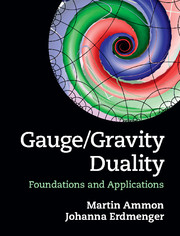Book contents
- Frontmatter
- Contents
- Preface
- Acknowledgements
- Part I Prerequisites
- Part II Gauge/Gravity Duality
- 5 The AdS/CFT correspondence
- 6 Tests of the AdS/CFT correspondence
- 7 Integrability and scattering amplitudes
- 8 Further examples of the AdS/CFT correspondence
- 9 Holographic renormalisation group flows
- 10 Duality with D-branes in supergravity
- 11 Finite temperature and density
- Part III Applications
- Appendix A Grassmann numbers
- Appendix B Lie algebras and superalgebras
- Appendix C Conventions
- Index
- References
9 - Holographic renormalisation group flows
from Part II - Gauge/Gravity Duality
Published online by Cambridge University Press: 05 May 2015
- Frontmatter
- Contents
- Preface
- Acknowledgements
- Part I Prerequisites
- Part II Gauge/Gravity Duality
- 5 The AdS/CFT correspondence
- 6 Tests of the AdS/CFT correspondence
- 7 Integrability and scattering amplitudes
- 8 Further examples of the AdS/CFT correspondence
- 9 Holographic renormalisation group flows
- 10 Duality with D-branes in supergravity
- 11 Finite temperature and density
- Part III Applications
- Appendix A Grassmann numbers
- Appendix B Lie algebras and superalgebras
- Appendix C Conventions
- Index
- References
Summary
In the preceding chapters we have studied examples of very non-trivial tests of the AdS/CFT correspondence. At the same time we have seen that the AdS/CFT correspondence is a new useful approach for studying strongly coupled field theories by mapping them to a weakly coupled gravity theory. This raises the question whether a similar procedure may be used to study less symmetric strongly coupled field theories, thus generalising the AdS/CFT correspondence to gauge/gravity duality. The prototype example where such a procedure is desirable is Quantum Chromodynamics (QCD), the theory of quarks and gluons, which is strongly coupled at low energies. Although a holographic description of QCD itself is not yet available, decisive progress has been achieved in many respects. We will discuss the achievements and open questions in this direction in chapter 13. Here we begin the discussion of generalisations of the AdS/CFT correspondence in a more modest, though well-controlled and simpler, way by considering the gravity duals of N = 4 Super Yang–Mills theory deformed by relevant and marginal operators. These deformations break part of supersymmetry, and relevant operators also break conformal symmetry.
Renormalisation group flows in quantum field theory
Perturbing UV fixed points
The term interpolating flows refers to renormalisation group flows which connect an unstable UV fixed point to an IR fixed point at which the field theory is conformal again. A flow of this type is obtained for instance by perturbing the theory at a UV fixed point by a relevant or marginal operator. Marginal operators typically lead to a line of fixed points, while relevant operators generate a genuine RG flow, which may end at an IR fixed point. A further issuse is whether the theory flows to a confining theory in the IR, as we will discuss in more detail in chapter 13. A field theory example of an interpolating flow will be given in section 9.1.3 below.
- Type
- Chapter
- Information
- Gauge/Gravity DualityFoundations and Applications, pp. 296 - 325Publisher: Cambridge University PressPrint publication year: 2015

